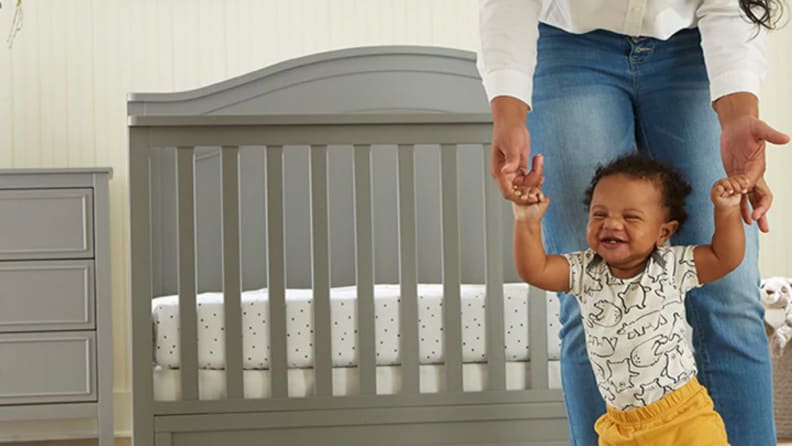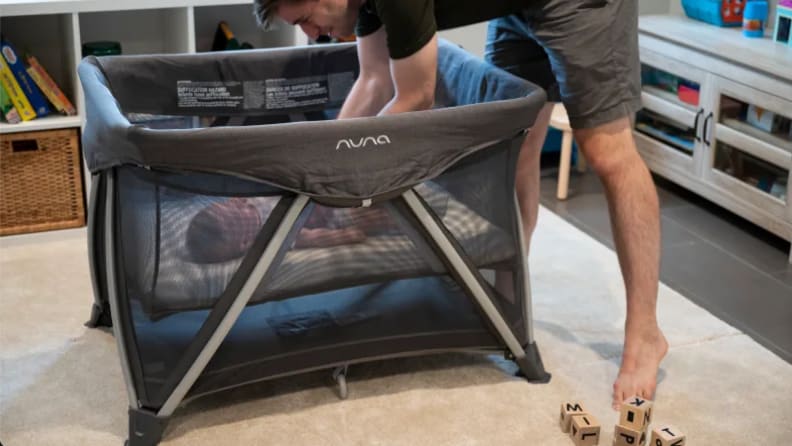Baby on the way? Here's how to choose the best crib
Everything you need to know before buying a baby crib
Products are chosen independently by our editors. Purchases made through our links may earn us a commission.
A baby crib is the focal point of any nursery—but the options for buying one can be pretty overwhelming. It can be hard to know how to choose a baby crib when there are so many options and styles to choose from.
There are lots of considerations as you search for the best possible baby crib for your family’s needs. Whether you shop for a standard crib, a bassinet, or a pack n' play, here is a checklist of everything you need to know.
Once you’ve selected the best crib for your needs, check out our recommendations for the best baby crib mattresses for babies, and don't forget to start thinking about baby monitors, so you can keep a close eye on your little bundle of joy while they slumber.
Does my baby need a crib?
In our opinion, yes. According to the CDC about 3,700 babies die annually from sleep-related causes. Creating the safest possible sleep environment for babies can help keep your baby safe. That includes keeping a baby’s sleep area free of any blankets, pillows, stuffed animals, or decorative bedding. That also means giving them their own place to sleep.
How long will we use a crib?
While the age when a child may transition from crib to toddler bed can vary greatly, on average most babies sleep in them for the first 24 months of life. If you’re wondering if it’s time to transition from a crib to a toddler bed, watch your child for signs. One tell-tale sign is if they are climbing out of their crib on their own.
Are there safety guidelines I need to know?
Glad you asked! Crib safety standards have changed a lot over the last decade and there are important things you need to know before shopping for a crib.
Buy new
Let’s get the most important piece of info out of the way first. While you may be tempted to buy second-hand or use an antique heirloom, keep in mind that crib safety standards were significantly updated in 2011 and continue to be refined. If you do decide to purchase second hand, be sure the crib was manufactured recently and be sure that it adheres to all current safety standards.
While a vintage crib may display beautiful craftsmanship, the slats rarely meet the current standard of 2 3/8 inches or fewer. This distance between slats helps protect a baby’s head from getting caught and injured between the slats or, worse, a baby choking when caught.
Look for new furniture that bears a safety certification seal from the Juvenile Product Manufacturers Association (JPMA) or check their database of certified cribs here.
Check older cribs for lead paint, and stay on top of the Consumer Product Safety Commission’s (CPSC) recall list.
If you absolutely must have a used or vintage crib, be sure to heed these crib safety guidelines by the American Academy of Pediatrics and the CPSC:
- Cribs must have fixed sides. Drop-side cribs are no longer allowed in the US.
- Crib bars should be spaced no more than 2 3/8 inches apart (about the width of a soda can). Check to make sure there are no missing or cracked slats.
- There should be no cutouts on the headboard or footboard of the crib.
- A crib mattress should be firm and tight-fitting within the crib and should not sag under your baby’s weight. You can test if the mattress is tight enough by inserting two fingers between the crib and the mattress. If the space is greater than two fingers, you’ll need a different mattress.
- There should be no missing, broken, or exposed hardware.
- Raised crib sides should be at least 26 inches above the mattress support in its lowest position.
- You should periodically lower the mattress as your child gets taller to ensure they are securely in their crib at night, without risk of climbing or falling out.
Check the paint
Cribs made before 1978 may have lead in their finish, which poses a serious health risk to infants and children. If you buy new this shouldn’t be a problem, but you may want to consider your finish options when selecting a new crib.
For a natural nursery, look for cribs that are either unfinished or finished with non-toxic paint with zero volatile organic compounds (VOCs). VOCs are chemicals, like phthalates and formaldehyde, which can off-gas and cause respiratory issues like asthma. We recommend looking at cribs that are Greenguard Gold certified. What that means is they have low to no chemical emissions.
Types of cribs
When shopping for different crib types, it’s important to take more than aesthetics into consideration. The best baby crib is going to be the one that suits your family’s needs and your space. Here is a sampling of cribs to consider.
Standard Cribs
Standard cribs have simple construction, with four fixed, slatted sides that do not drop down. Most standard cribs will allow for you to raise or drop the mattress depending on your child’s age and—once they are toddlers—level of athleticism.
Typically made from wood such as maple, oak, cherry, ash, mahogany, birch, and beech, standard cribs tend to be long-lasting and are a great choice for growing families that may anticipate having more than one child, as they will have the durability to last for years. Do know, however, that in more recent years there has been a trend for cribs to be made of pine. Pine is a softer wood and will not only knick easily, it will likely turn your crib into a large-scale teether for your baby.
Convertible cribs

A convertible crib can last your baby through adolescence.
Convertible cribs are popular for being long-lasting furniture that has the ability to grow with your child from infant to toddler to child. These 3- or 4-in-1 beds make for a simpler transition from crib to toddler bed, day bed, or full-sized bed and—for some—can last through adolescence.
Reviewed’s favorite baby crib is a 4-in-1 convertible crib by DaVinci which is, incidentally, the crib our family had for our son.
The pros of having a convertible crib is being able to have your child’s crib grow with them at a moment’s notice. The first morning our son catapulted himself over the rails, our convertible crib allowed us to transform his baby crib to a toddler bed at a moment's notice.
The cons of a convertible crib can be that the style you picked for your child’s baby room may not be one that grows with them. Be sure to choose a convertible crib with a timeless design or subtle color scheme. Even still they may beg for a bunkbed when they turn 7, like our child did, which will reduce their overall longevity. Get the Davinci Autumn 4-in-1 Convertible Crib at Amazon for $249
Mini cribs
These tiny space-saving solutions are great for families in tighter living spaces. While small, these portable cribs still have many of the same features as a standard-sized crib and, with their adjustable-height mattresses, they can be a smart alternative to a bassinet.
What mini cribs also tend to have that not all full-sized cribs have are gliders that make these cribs mobile enough to move from room to room. These can be great for families that need more mobility, however, that also means caregivers need to be diligent about locking the breaks when the baby is in it.
Bassinets
Bassinets are ideal for your baby’s first 3 to 6 months of life—particularly when they are sharing a room with you. A bassinet is also a good small-space sleep solution for families that want to forgo a mini-crib but aren’t quite ready to move their baby to a full-sized crib. It’s recommended that a baby be moved to a standard crib once they start rolling over.
Get the Chicco LullaGo at Amazon for $149
Travel cribs

Pack n' Plays are a good short-term sleep solution, but they will show wear and tear quickly if used as a permanent place for your baby to sleep.
Often referred to as pack n’ plays and play yards, travel cribs are great for families on the go. They are not only a good option when you’re away from home, but when you need your baby to nap near you outside of their nursery.
Travel cribs are lightweight and often have mesh siding, which helps ensure air circulation while baby is sleeping. These cribs can be prone to wear and tear, so we don’t recommend them as a permanent sleep solution.
Get the Chicco Alfa Lite at BuyBuyBaby for $159
The product experts at Reviewed have all your shopping needs covered. Follow Reviewed on Facebook, Twitter, Instagram, TikTok, or Flipboard for the latest deals, product reviews, and more.
Prices were accurate at the time this article was published but may change over time.


